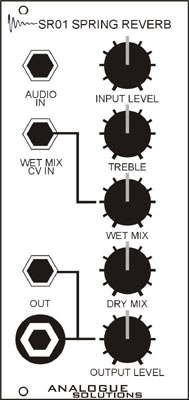| Module |
Controls & Ins/Outs |
 |
SR01 Spring
Reverb with VCA
Inputs:
Audio In
Wet Mix Level CV 0-12V
Outputs:
3.5mm audio out
6.35mm audio out
Power: +/-12V
Controls:
Input Level, Treble, Wet Mix, Dry Mix, Output, Level
Size: 12HP
Spring Specification:
Dual spring, length: 160mm x2. Feedback/shock reducing mountings.
Output Level Rever time approx. 2 to 4 seconds (frequency dependent). |
Introduction
Natural reverbaration is caused by reflected sounds, and in
a normal room most of these reflections come from the walls and Ceiling. It is important
to differentiate between reverb and echo; an echo is heard as clear repetition of the
original sound, whereas reverb consists of numerous reflected sounds which normally come
only marginally behind the original sound.
Reverbaration tends to enhance sounds by giving depth and
colour, and artificial reverbaration is understandably a very popular effect. There are
several non-digital ways of producing artificial reverb, but one of the best methods that
produces excellent results at a low cost is the spring-line system as used in the SR01.
Spring reverb is the same type of reverb found built into the EMS VCS3 and ARP2600.
A spring-line normally consists of 2 long springs mounted
side by side, and having an input transducer at one end and an output transducer at the
opposite end. A signal applied at the input transducer results in sound waves being
transmitted down the springs, and these are desinged so that there is a significant delay
time. Also, in order to produce a more realistic effect it is normal for the springs to
give different delay times. The sound waves produce an output signal when they reach the
output transducer, but some of the energy is reflected back to the input transducer, and
then back to the output transducer where further output signal is produced. In fact, the
energy will be reflected up and down the springs numerous times, gradually diminishing
until no significant output is produced.
This is obviously analogous to sounds being reflected
around a room, and for such a simple system, can give a very realistic effect.
Fitting Details (full details in manual)
Remove spring line from cardboard box. The spring is small
enough to fit inside most 3U and 6U cases. To keep mains hum to a minimum, mount spring as
far away as possible from the mains transformer. Make sure there is enough clearance for
the module PCBs, and that it is clear from the power supply. Ensure no cables interfere
with the spring.
General Use
Everything self explanatory really. Feed audio into the
spring reverb, take it out into your mixer. All controls self-explanatory. The Wet Mix CV
input has a 0-12V range to vary the wet mix level. When using the wet mix CV input, the
wet mix control becomes a level offset.
The treble cuts the top end before the signal enters the
spring.
Feed you VCO straight into the Reverb, with dry mix to
minimum, and wet mix up high. If the pitch is kept constant the VCO takes on a new timbre
- strange and metallic. With subtle triangle LFO modulation on the VCO pitch, you start to
get a chorusing effect.
Echo Effect
Set-up the reverb as normal. Feed a gate/clock or square
LFO waveform signal into the wet mix CV input, and turn the wet mix to a low value. This
way the reverb affect sound will be gated as it decays away, creating an echo style
effect. (Thanks to Tim Hannigan for this patch).
Weird Effects
Bashing the casing or scraping the springs (not a good idea
when spring is mounted inside new to the power supply) is very avant garde.
